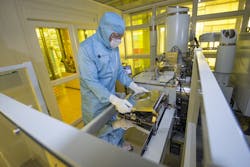UK's silicon-photonics consortium gets £4.8 million boost to R&D innovation funding
Rockley Photonics (Oxford, England), which produces integrated technology and systems for next-generation networks, will over the next five years match government funding from the United Kindom's (UK's) Engineering and Physical Sciences Research Council (EPSRC) and form a "Prosperity Partnership" with the University of Southampton’s Optoelectronics Research Centre (ORC).
The money, totaling around £4.8 million, will be used to support research into how silicon-photonics technology can be used to improve data-center communication networks and to support a new integrated-photonics platform for mass-market applications.
"Rockley Photonics and The University of Southampton team has a long-standing history of working together," says Andrew Rickman, founder, CEO and chairman of Rockley Photonics. "Our partnership, built up over many years, demonstrates the value of relationships between academia and commercial enterprises such as ours. It gives us the ability to combine resources and academic excellence and focus on ground-breaking, early-stage technologies, such as silicon photonics. Research in this area is progressing quickly, and in the very near future, this game-changing, disruptive technology will soon have a huge impact on the future architecture design of large data centers, improve the power and compute capacity of new consumer devices, and provide robust sensing solutions in a variety of industry sectors, such as autonomous vehicles and biomedical. All this at dramatically lower cost and with considerably less power requirements."
The challenge ahead
Data centers are currently consuming about three percent of the global electricity supply – 416.2 terawatt hours last year. That is more than the total consumption of many individual European countries, including the Netherlands, Norway, Sweden, Poland, and the United Kingdom.
Some of the world's key challenges are handling and manipulating the enormous amounts of data associated with the modern world, as well as the energy implications of doing so. Silicon photonics is seen as one of the key technologies to solve some of these key challenges, particularly in the deployment of energy-efficient solutions for large data centers, as well as applications in high performance computing.
Source: Rockley Photonics
About the Author
John Wallace
Senior Technical Editor (1998-2022)
John Wallace was with Laser Focus World for nearly 25 years, retiring in late June 2022. He obtained a bachelor's degree in mechanical engineering and physics at Rutgers University and a master's in optical engineering at the University of Rochester. Before becoming an editor, John worked as an engineer at RCA, Exxon, Eastman Kodak, and GCA Corporation.

